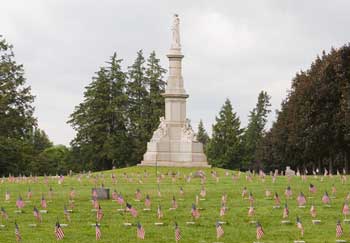The Soldiers National Cemetery
Over 4,500 soldiers were killed during the three days of battle. At the end of the fighting, men trod over the terrible scene looking for fallen friends. If they were lucky, they found the missing man and gave them a decent burial. Sadly these cases were few. As the Army of the Potomac held the field after the battle, the Union soldiers were given the distasteful duty of interring most of their own dead as well as the fallen Confederates. The burials were completed as quickly as possible, the bodies laid into shallow graves near the spot they had fallen and quickly covered. Crude grave markers were boards taken from hardtack boxes or fence planks. Many of the dead were unidentified as they had no name tags. Farmer's fields, orchards, woodlots and farmyards became vast cemeteries. Heavy rains during the month of July washed away much of the soil thrown over the burials.
It was a very disheartening scene and several local officials were so alarmed that they quickly sprung to action. Governor Andrew Curtin of Pennsylvania became involved with the project and state funds were appropriated to develop a proper ceremonial burial ground for the Union dead at Gettysburg. Confederate soldiers buried on the battlefield were not considered for the cemetery as they were the enemy of the Union. The cemetery was designated as a final resting place only for those men who fell in service to the Federal government.
After many weeks of letter writing and planning, William Saunders was hired to lay out the cemetery. Saunders was a highly respected landscape architect who saw the cemetery as a ground of equality for all of the states which had sacrificed so much in blood during the battle. Saunders' design was approved and the relocation of dead to the cemetery began that fall. A local man named Samuel Weaver was hired to remove the dead from graves for re-burial in the new cemetery. The process was slow as Weaver had to locate and examine thousands of graves spread out over a vast area. With as much care as possible, he made every attempt to identify the remains and gathered personal items from the grave. A team of laborers then placed the remains in a wooded casket and buried them in the designated state plots of the cemetery. Most were interred in state plots which surround the open center, a place set aside for a monument that would be constructed after the close of the war. Those with no identification were placed in one of two sections marked "Unknown".
The cemetery was only partially filled when it was dedicated on November 19, 1863. It was a brisk fall day and the ceremony was attended by many officials from Washington, Baltimore, and Pennsylvania. Representatives from other northern states also attended. Gettysburg residents who had suffered through the hardship of the battle turned out in great numbers, filling the cemetery grounds to hear President Lincoln speak. The Marine Band played to open the ceremony, followed by a prayer and introductions. Mr. Edward Everett was asked to give the main address that day, and the crowd fell silent as he rose and spoke. Everett's words echoed through the crowd who stood among the temporary headboards of the Gettysburg dead.
Also on the platform was President Abraham Lincoln, the special guest who had been invited to speak a few words during the dedication by Gettysburg attorney David Wills. The president sat on the platform with many eyes still trained on him. What was he thinking as he looked out over that mournful crowd? Beyond the town lay the rolling countryside of south-central Pennsylvania still scarred by the battle. Beyond the vast farms lay the South Mountains, rising clear into the blue skies, framing the solemn scene. Could the president have been thinking of the human cost in lives which the war had already taken? Was he remindful of the price of freedom, and of the sacrifices of so many men and families on both sides? Or was he thinking of his own son who lay sick in bed in Washington?
Mr. Everett's speech lasted nearly two hours, finally ending in a crescendo of patriotism and sacrifice. A brief musical interlude followed and then the president was introduced. Rising from his chair, President Lincoln spoke with a clear voice filled with both sympathy and determination. His words were brief and his speech ended before many could comprehend his meaning. Yet with his short speech to the crowd in the cemetery, President Lincoln renewed the meaning of a democracy and the cause of the Union- to reunite the nation as one. By doing so, they would honor the dead who had made the supreme sacrifice on the bloody fields of Gettysburg.
Burials in the cemetery were finally completed in 1864 and the Soldiers Monument was erected in the center of the cemetery in 1869. By 1872, the entire cemetery project was complete and it was turned over to the Federal government to manage. Confederate graves on the battlefield and at hospital sites remained untouched until 1871 when ladies' organizations in North and South Carolina, Georgia and Virginia organized an effort have the southern dead removed for burial in southern cemeteries. By 1873, the last Confederate soldier that could be found was sent for burial at Hollywood Cemetery in Richmond, Virginia.
Today, the Soldiers National Cemetery is called the Gettysburg National Cemetery. The cemetery holds the graves of honored dead from all of America's major wars and is marked with passages of the touching poem "Bivouac of the Dead" by Theodore O'Hara.
